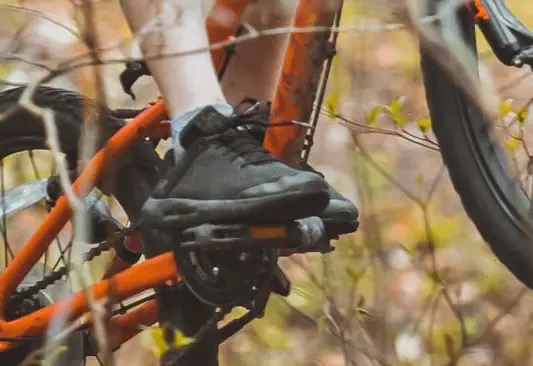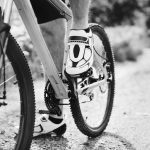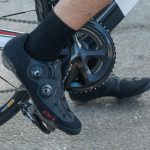When getting into mountain biking, having the right gear makes all the difference in enjoying the sport. One key piece of gear that is often overlooked are mountain bike shoes. Having shoes that properly fit your feet and match the type of pedals on your bike leads to better power transfer, comfort, and control. This article covers everything you need to know about selecting and using mountain bike shoes.
Types of Mountain Bike Shoes
There are a few main types of mountain bike shoes to consider based on the pedal system you use. The shoes need to match the pedals to ensure proper engagement and power transfer.
The first type is shoes made for use with flat pedals. Flat pedal shoes have stiff soles to ensure efficient pedaling, but they look almost like normal athletic sneakers. The soles have aggressive tread to grip the pedals. Using specific shoes helps keep your feet from getting bounced off the pedals.
Clipless mountain bike shoes are made to lock into clipless pedals. The cleats on the bottom screw into the pedals to connect your feet securely for maximum power transfer. Stiff soles also help. The shoes come in different styles from casual to very technical.
There are also shoes made for use with combo pedals which have a flat pedal platform on one side and an SPD clipless mechanism on the other side. These allow you to ride clipped in or just with flat shoes.
Key Features of Mountain Bike Shoes
Mountain bike shoes have several important features that affect power transfer, traction, and comfort. Understanding these helps select the right model.
The stiffness of the sole is critical. Stiff soles efficiently transfer power from your legs to the pedals. Different shoes use varying materials like carbon fiber and nylon to impact stiffness.
The tread and shape of the outsole is optimized for grip and shedding mud depending on conditions. Lug patterns help connect firmly to flat pedals. Some shoes are almost like hiking boots for very aggressive trails.
The upper material impacts ventilation, water resistance, and protection. Mesh uppers breath well while synthetic leather resists moisture and abrasion. Protective rubber caps and toe bumpers guard from rock strikes.
Insoles can be customized to support your feet. Aftermarket insoles provide more cushion or arch support. Heat moldable shoes conform precisely to your feet.
Getting the Right Mountain Bike Shoe Fit
Fit is essential in mountain bike shoes. Shoes that are too loose can lead to your feet bouncing off the pedals while shoes that are too tight can cause pain and numbness.
Ideally, go to a bike shop and try on various models in your size. Everyone’s feet are a bit different so brand and model makes a difference. Athletic shoes often fit very differently from mountain bike shoes. Factor in swelling after hard rides too.
For clipless shoes, the cleat mounts should support your foot well without pressure points. The shoes may feel tight out of the box but break-in after a few rides. Heel lift indicates they are too big. They should hold your heel firmly in place without rubbing.
Pay attention to toe room both length and height wise. Having your toes jammed into the front of shoes for long descents can be very painful. Give them some wiggle room.
Breaking In and Taking Care of Your Shoes
Brand new mountain bike shoes usually need to be broken in slowly to maximize comfort over time. The materials mold better to your feet with light use.
Start by wearing them for short rides before big adventures to allow your feet to adapt. Use the ratchets or laces to fine tune the fit across different parts of your feet. Hot spots are normal at first.
Over time the break-in process adjusts the shoes precisely to your feet. Then they provide superior power transfer and control. It is worth investing this time upfront to get shoes dialed.
In terms of care, keep the tread clear of debris that could interfere with pedal grip. Let sweaty shoes dry out well between uses to prevent bacteria buildup. Use shoe fresheners as needed. Store shoes with the ratchets opened up so they don’t take a permanent set formed to your feet.
Clipless Versus Flat Mountain Bike Shoes
Both clipless and flat pedal shoes can work very well for mountain biking. It comes down to personal preference and riding style. Clipless provide maximum power transfer while flats allow quicker foot movements.
Clipless shoes lock your feet securely to the pedals using a cleat that clicks into the pedal mechanism. This direct connection allows you to pull up as well as push down for more pedaling power. The stiff soles also put all your energy straight into spinning. This leads to less fatigue on long climbs. Kneecap pain is reduced as well. However, clipping in and out constantly on very technical trails can be annoying. And crashing with feet stuck to the bike is potentially risky.
Flat pedal shoes rely on the grip of the rubber sole to stick to the pedals via traction and foot pressure. This makes it easy to quickly dab a foot out or adjust foot position on ledges. The shoes offer freedom useful for tricks too. But flat pedals lose some efficiency that clipless setups provide. Also more ankle strength and stability is required. Flats are popular with downhill and dirt jump riders.
Many mountain bikers actually have bikes, or at least wheelsets, set up with both flat and clipless pedals. They switch as desired for different types of riding. Mixing parts is easy with shoes designed for combo pedals that work either way. Start with what appeals based on the terrain you tackle most. As technique develops, consider trying the alternate for comparison.
Other Mountain Bike Shoe Considerations
Along with getting shoes that match your pedal system, fit well, and ride style, a few other factors play into mountain bike shoe selection. These include traction, weather protection, and shoe adjustments.
As mentioned earlier, lug patterns on shoe soles provide traction that keeps your feet planted on flat pedals. More aggressive tires demand shoes with sturdier gripping ability. Also consider spikes that screw into some mountain bike shoes for icy winter conditions. These grip on snow and mud too.
Weather protection involves keeping feet dry in wet conditions and cool during hot weather. Shoes built with water resistant panels or ventilation ports help moderate temperature and moisture. Some models even have drains in the sole to let water out. Wool or other advanced fabrics aid performance across conditions.
Fine tuning the fit of mountain bike shoes matters to comfort over long miles. Look for quick lacing systems that provide even pressure adjustment across the foot. Others utilize a Boa dial for incremental tightening of the uppers. Heat moldable shoes that conform to your feet shape work well too. Consider aftermarket insoles to optimize support too.
Get all the details right on your mountain bike shoes, and you will reap the benefits in better performance and more enjoyment hitting the trails. Get recommendations from other local riders too on conditions in your area. Then enjoy pedaling more comfortably wherever you ride.






